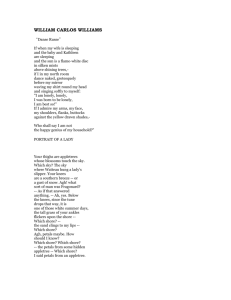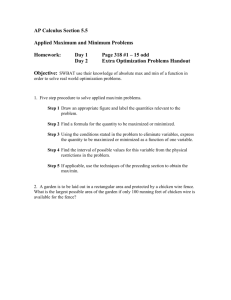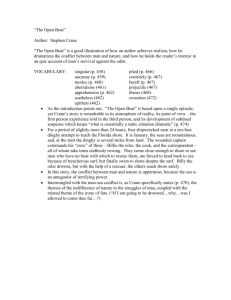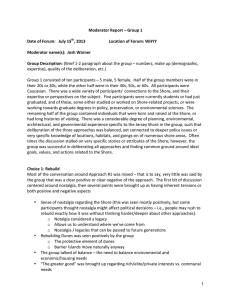Works Cited
advertisement
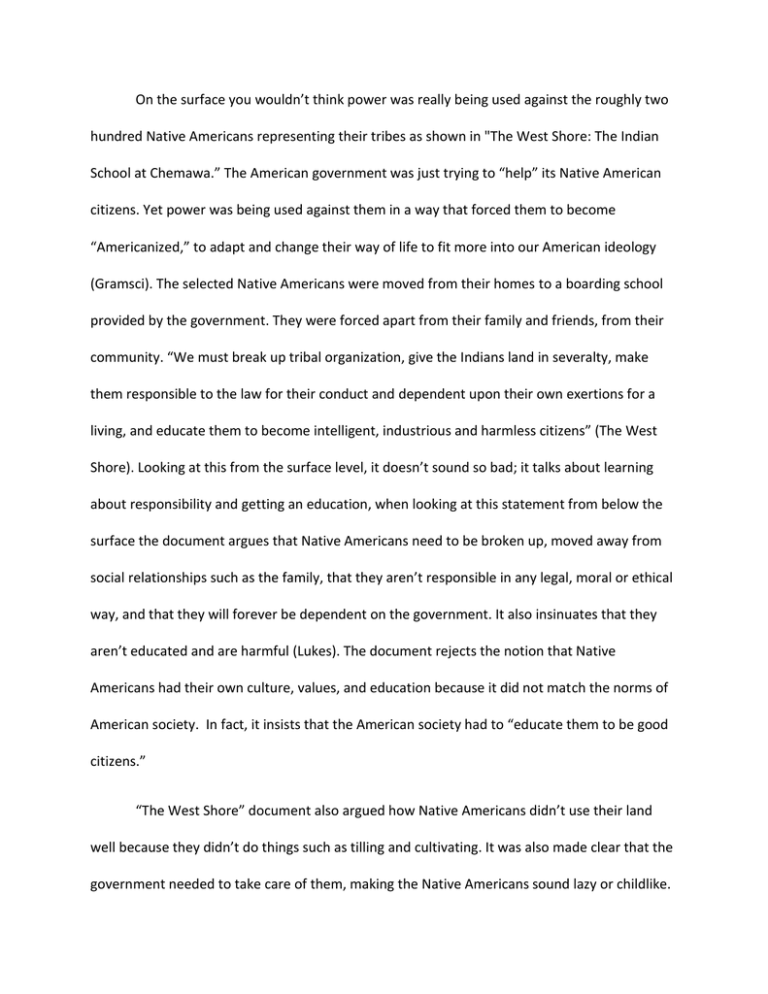
On the surface you wouldn’t think power was really being used against the roughly two hundred Native Americans representing their tribes as shown in "The West Shore: The Indian School at Chemawa.” The American government was just trying to “help” its Native American citizens. Yet power was being used against them in a way that forced them to become “Americanized,” to adapt and change their way of life to fit more into our American ideology (Gramsci). The selected Native Americans were moved from their homes to a boarding school provided by the government. They were forced apart from their family and friends, from their community. “We must break up tribal organization, give the Indians land in severalty, make them responsible to the law for their conduct and dependent upon their own exertions for a living, and educate them to become intelligent, industrious and harmless citizens” (The West Shore). Looking at this from the surface level, it doesn’t sound so bad; it talks about learning about responsibility and getting an education, when looking at this statement from below the surface the document argues that Native Americans need to be broken up, moved away from social relationships such as the family, that they aren’t responsible in any legal, moral or ethical way, and that they will forever be dependent on the government. It also insinuates that they aren’t educated and are harmful (Lukes). The document rejects the notion that Native Americans had their own culture, values, and education because it did not match the norms of American society. In fact, it insists that the American society had to “educate them to be good citizens.” “The West Shore” document also argued how Native Americans didn’t use their land well because they didn’t do things such as tilling and cultivating. It was also made clear that the government needed to take care of them, making the Native Americans sound lazy or childlike. Also, some of the steps the government took to help the Native Americans are described. The main step that the government felt like they needed to take involved educating the offspring of the Native Americans. The American government started educating them in common American public schools, and instructing them in ordinary trades and agriculture. The government used its institutional power to forcibly instill its American values. The government was able to do this because American individuals as a general whole have internalized the norms of the American values. The same values were used not only to educate the Native American’s latest generation the way they wanted to, but also to move them away from their families and elders (Gramsci). The American government felt that when the Native American children went back home after school, they wouldn’t practice what they were being taught at public school since their families, being “uneducated”, would not be practicing those things. A quote sums up one of the reasons why the United States government continued to “Americanize” the Native American students: “The crying shame is that he is at once subjected to those demoralizing influences, and degrading mode of life” (The West Shore). That statement was about the Native Americans when they come home after gaining their government education. How after being “Americanized” they would have to go home and be around what the government felt to be like a lazy, demoralizing and a degrading type of lifestyle. It is obvious that the government did not care for, or respect the Native American’s way of life. This would create many different kinds of identity issues because they were being taught at school that their people (tribes) were immoral and that on the reservation they were all living a degrading life. One type of identity issue that might come up would probably be that Native Americans would feel ashamed of being Native because of how the institution and the “Normal” people who follow the institution viewed the tribes on reservations. And more than this, how could the Native American students still be accepted by their tribe and family? How can someone feel comfortable with who they are if a majority is trying to make them ashamed of where they come from while their loved ones try to get them to embrace what they are being taught to be ashamed of ( Schwalbe )? One of the ways they integrated the Native American students was by enforcing an English-only rule, but upon first attending the school they could not speak English. They were forced to learn fast otherwise they weren’t really able to communicate with others. Power at that point is easily seen as being used as majority vs. minority. Power was being used against the Native Americans through the government by monitoring the education system that the teachers worked under. (Arendt). This also shows a few of the nets of accountability in play. An illustration of this could be that if the teacher didn’t force the children to speak only English, the teacher could possibly lose her job, because the teacher has to answer to someone for her actions such as the principal. Just like how the teacher has to answer to the principal, the principal has to answer to someone in a higher position in the education hierarchy. All in all, there are a lot of forces of power at play that are not in the Native American students’ favor (Schwalbe). Besides cultural assimilation, the Native American students were forced into performing free labor for the same system that would brain wash them into self-loathing. For example, “The West Shore” detailed Native American students clearing out 40 acres of land for their school. On the first dimension this doesn’t seem horrible because it is for their school, but this is a public school. Do non-Natives have to clear out land for their public schools? When you feel like you’re stuck in a system of oppression, you’ll probably just go along with things such as this because you feel there isn’t anything you can really do to change things. After all, the system that they were in took them from their homes made to completely change their lifestyles like how they speak and what they wear, and throughout this whole thing were being told it was for their own good, implied that this makes them better ( Foucault ) and more “American” (Gramsci). These tactics are demonstrations of power being used completely against the Native American students. When the Native American students weren’t in class they had a very strict daily schedule that they had to stick to. Not only did they spend half their day learning in school but they spent another half of it working. They worked making their own shoes, doing laundry, working in the kitchen or on the farm as well as many other types of work. This was stated in “The West Shore” as “recreation” (Foucault). But how can recreation, something that should be of choice, be fun if it’s forced and mandated? It seems that they are being punished for not being like the majority thus why they were being forced to work as “recreation”. The punishment here is a social function as well as a political tactic both of which are working against the Native American students. The conditioning that took place when the Native American students were forced to leave their homes, their tribes, and their families, made them see the power being used against them as justified, a good thing. They learned to be ashamed of their people, their culture, and had learned through their social conditioning at school that they wanted to be like the majority. In the statement “We are not well educated yet, and do not know how to work well, but in the near future we hope to become a credit to ourselves, our country and our people” (The West Shore) it is easy to see that many were conditioned into not seeing how power was being used against them. Works Cited Arendt, Hannah. On Violence. Florida: 1969. Foucault, Michel. Discipline and Punish: The Birth of the Prison. 1995 Gramsci, Antonio. Selections From The Prison Notebooks. New York: International Publishers. H.L. Wells, “The Indian School At Chemawa.”The West Shore, 1 (January 1887): 5-12. Lukes, Steven. Power: A Radical View. 1974. Schwalbe, Michael. Rigging the Game: How Inequality Is Reproduced In Everyday Life. Ohio: Oxford University Press, 2007. Young, Iris Marion. Justice and the politics of Difference. New Jersey: Princeton University Press, 1990.
